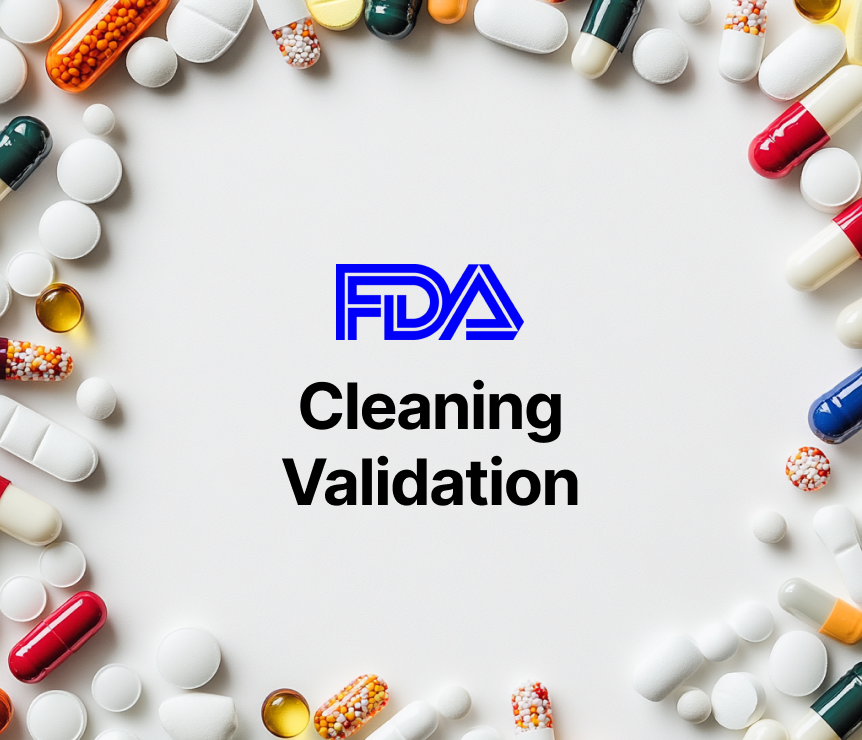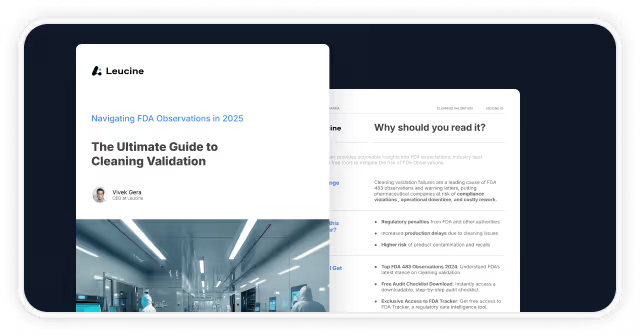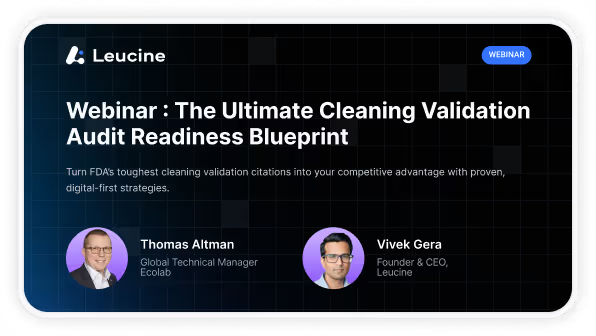2025 FDA Warning Letter Trends: What Pharma Can Learn from This Year's Top Citations

The pharmaceutical industry continues to face intense FDA scrutiny in 2025, with warning letters highlighting persistent challenges in aseptic practices, data integrity, and quality systems. For QA, QC, and compliance professionals, understanding these trends isn't just about staying informed—it's about building proactive strategies that prevent costly regulatory actions and protect patient safety.
This year's warning letters reveal critical patterns that every pharmaceutical manufacturer must address. From poor aseptic practices and peeling paint in cleanrooms to inadequate supplier qualification procedures, the FDA's enforcement actions provide a roadmap for strengthening compliance programs.
The Big Picture: 2025 FDA Enforcement Landscape
Quality system issues remain the most common violation, accounting for over 30% of all citations, while data integrity has emerged as a major concern, rising significantly in recent years. The shift toward systemic quality issues rather than isolated procedural failures signals the FDA's increased focus on organizational culture and comprehensive compliance programs.
The agency has also intensified its scrutiny of foreign manufacturers, with the proportion of warning letters issued to foreign facilities increasing from 22.9% in 2019 to 33% in 2020, and this trend continues into 2025 with significant enforcement actions against facilities in India, China, and other international locations.
Learn how to build audit-ready quality systems: 4 Pillars of a Strong QMS
Top 5 Warning Letter Trends in 2025
1. Supplier and CMO Oversight Failures
One of the most significant trends in 2025 is the FDA's increased focus on how companies manage their contract manufacturing organizations (CMOs) and suppliers. AACE Pharmaceuticals received a warning letter after their CMO Brassica Pharma exhibited poor aseptic practices, fabricated microbiology records, and used ripped and dirty gowning.
The critical issue? AACE's quality unit failed to have adequate supplier qualification procedures and requalified Brassica in 2023 without evaluating whether corrective actions adequately addressed identified deficiencies.
Key Lesson: Supplier qualification must be an ongoing, risk-based process—not a checkbox exercise. Companies need robust oversight of CMOs that includes regular audits, performance monitoring, and thorough evaluation of corrective actions.
2. Aseptic Processing and Cleanroom Integrity
Rechon Life Science AB in Sweden received a warning letter for aseptic process violations, including operators touching products with gloved hands and peeling paint in cleanroom environments. These observations highlight fundamental breakdowns in aseptic technique and facility maintenance.
Environmental monitoring continues to be a critical focus area, with inadequate investigations into environmental monitoring excursion results being frequently cited.
Strengthen your environmental monitoring program: Environmental Monitoring Guidelines for Effective Compliance
3. Equipment Design and Cross-Contamination Control
Yiling Pharmaceutical in China was cited for using non-dedicated equipment with poor sealing, allowing drug residues to accumulate in ducts. Their inadequate response to testing only the preceding drug substance instead of all substances processed on the equipment demonstrated insufficient understanding of cross-contamination risks.
This trend reflects broader issues with equipment qualification and cleaning validation programs that fail to address worst-case scenarios adequately.
4. Data Integrity and Laboratory Controls
Data integrity remains the main issue the pharmaceutical industry is currently dealing with, with failures potentially resulting in unvalidated results and frequent product recalls. Common violations include:
- Incomplete or missing laboratory records
- Inadequate access controls to electronic systems
- Failure to investigate out-of-specification results
- Manipulation or deletion of critical manufacturing data
ABR Laboratory in Florida was cited for not using suitable methods to test OTC drugs and failing to investigate out-of-range temperature and humidity readings, including a refrigerator reaching 17.4°C when it should have been 2-8°C.
5. Quality System Inadequacies
The FDA frequently cited firms for inadequate quality control procedures under 21 CFR 211.22, with 36 letters mentioning failures to establish adequate written procedures. Advanced Pharmaceutical Technology received a warning letter specifically noting that "your firm's quality systems are inadequate".
These citations reflect systemic failures in:
- Quality unit responsibilities and oversight
- Written procedure development and implementation
- Batch release testing and documentation
- Corrective and preventive action (CAPA) programs
Build comprehensive quality systems: Everything You Need to Know in Quality Management System in Pharma
Geographic and Industry-Specific Patterns
2025 data shows continued enforcement against international manufacturers, particularly in:
- India: Multiple citations for fabricated records and inadequate facility maintenance
- China: Equipment design failures and insufficient raw material testing
- Europe: Aseptic processing violations and environmental monitoring gaps
Chinese manufacturer Linghai ZhanWang Biotechnology was placed on Import Alert 66-40 for inadequate component testing, specifically failing to test ethanol for methanol contamination.
The Cost of Non-Compliance
Warning letters in 2025 continue to have severe business consequences:
- Import Alerts: 27 warning letters cited import alerts, with 25 specifically referencing IA 66-40 for firms not meeting drug GMPs
- Product Recalls: Quality failures leading to market withdrawals
- Regulatory Delays: FDA may withhold approval of new applications until violations are completely addressed
- Reputation Damage: Public availability of warning letters impacts customer confidence
Proactive Strategies: Learning from 2025 Trends
Strengthen Supplier Oversight
- Implement risk-based supplier qualification programs
- Conduct regular CMO audits with qualified personnel
- Establish robust corrective action verification processes
- Monitor supplier performance through KPIs and trending
Enhance Aseptic Operations
- Validate media fill programs to accurately simulate commercial operations
- Implement comprehensive environmental monitoring with IoT-based real-time systems
- Establish preventive maintenance programs for cleanroom integrity
- Train personnel on proper aseptic techniques with regular competency assessments
Modernize Quality Systems
- Deploy digital QMS platforms for comprehensive documentation and trending
- Implement robust data integrity programs following ALCOA+ principles
- Establish effective CAPA systems with root cause analysis capabilities
- Create quality culture initiatives that emphasize continuous improvement
Download our comprehensive audit readiness resources: Batch Manufacturing Audit Readiness Checklist
Technology Solutions for Compliance
The increasing complexity of FDA expectations requires sophisticated technology solutions:
- Digital Environmental Monitoring: Real-time tracking and automated deviation management
- Integrated QMS Platforms: Centralized management of quality processes, documentation, and trending
- AI-Powered Analytics: Predictive insights for risk management and compliance monitoring
Modern platforms like Leucine provide comprehensive solutions that address multiple warning letter trends simultaneously, from environmental monitoring automation to integrated quality management systems.
Building a Warning Letter-Resistant Organization
Beyond addressing specific technical issues, 2025 trends emphasize the importance of organizational culture and systematic approaches to compliance:
Leadership Commitment
- Executive engagement in quality initiatives
- Resource allocation for compliance programs
- Clear accountability structures
Continuous Improvement Culture
- Regular self-assessments and gap analyses
- Proactive identification and remediation of risks
- Learning from industry trends and peer experiences
Training and Competency
- Role-specific training programs
- Regular competency assessments
- Cross-functional understanding of quality requirements
Stay informed about compliance trends: Sign up for FDA Tracker updates
Conclusion: From Reactive to Proactive Compliance
The 2025 FDA warning letter trends reveal that successful pharmaceutical manufacturers are moving beyond reactive compliance toward proactive, technology-enabled quality systems. Organizations that integrate robust supplier oversight, modernize their environmental monitoring capabilities, and implement comprehensive quality management systems are better positioned to avoid regulatory actions.
The key takeaway? Warning letters are preventable when companies invest in the right systems, processes, and culture. By learning from this year's trends and implementing proven compliance strategies, pharmaceutical manufacturers can transform regulatory risk into competitive advantage.
Ready to strengthen your compliance posture? Download our QMS Audit Readiness Checklist and build a warning letter-resistant quality system.
Frequently Asked Questions
What are the most common reasons for FDA warning letters in 2025?
The top reasons include inadequate supplier oversight, aseptic processing violations, data integrity failures, equipment design issues, and systemic quality system inadequacies.
How can companies prevent FDA warning letters?
Prevention requires a comprehensive approach including robust quality systems, proactive supplier management, digital monitoring technologies, regular training programs, and a strong compliance culture.
What should companies do if they receive a warning letter?
Companies must respond within 15 working days with a detailed corrective action plan, conduct thorough root cause analysis, implement systemic improvements, and often engage qualified consultants as recommended by the FDA.


























.png)
